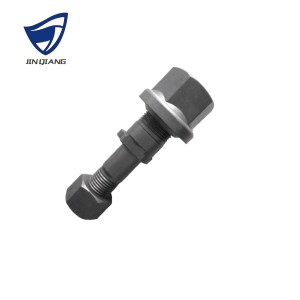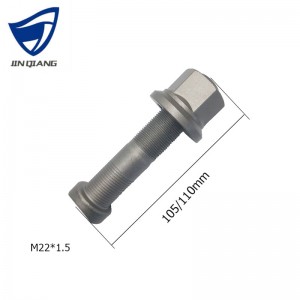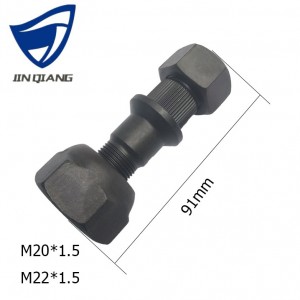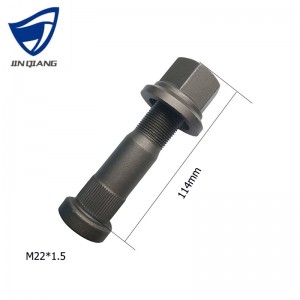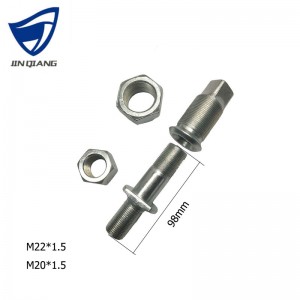Product description
Hub bolts are high-strength bolts that connect vehicles to the wheels. The connection location is the hub unit bearing of the wheel! Generally, class 10.9 is used for mini-medium vehicles, class 12.9 is used for large-sized vehicles! The structure of the hub bolt is generally a knurled key file and a threaded file! And a hat head! Most of the T-shaped head wheel bolts are above 8.8 grade, which bears the large torsion connection between the car wheel and the axle! Most of the double-headed wheel bolts are above grade 4.8, which bear the lighter torsion connection between the outer wheel hub shell and the tire.
Advantage
• Quick and easy installation and removal using hand tools
• Pre-lubrication
• High corrosion resistance
• Reliable locking
• Reusable (depending on usage environment)
Our Hub bolt quality standard
10.9 hub bolt
| hardness | 36-38HRC |
| tensile strength | ≥ 1140MPa |
| Ultimate Tensile Load | ≥ 346000N |
| Chemical Composition | C:0.37-0.44 Si:0.17-0.37 Mn:0.50-0.80 Cr:0.80-1.10 |
12.9 hub bolt
| hardness | 39-42HRC |
| tensile strength | ≥ 1320MPa |
| Ultimate Tensile Load | ≥406000N |
| Chemical Composition | C:0.32-0.40 Si:0.17-0.37 Mn:0.40-0.70 Cr:0.15-0.25 |
Manufacturing process of bolts
1、Spheroidizing annealing of high-strength bolts
When the hexagon socket head bolts are produced by the cold heading process, the original structure of the steel will directly affect the forming ability during cold heading processing. Therefore, the steel must have good plasticity. When the chemical composition of the steel is constant, the metallographic structure is the key factor determining the plasticity. It is generally believed that the coarse flaky pearlite is not conducive to cold heading forming, while the fine spherical pearlite can significantly improve the plastic deformation ability of the steel.
For medium carbon steel and medium carbon alloy steel with a large amount of high-strength fasteners, spheroidizing annealing is performed before cold heading, so as to obtain uniform and fine spheroidized pearlite to better meet the actual production needs.
2、 Shelling and descaling of high-strength bolts
The process of removing iron oxide plate from cold heading steel wire rod is stripping and descaling. There are two methods: mechanical descaling and chemical pickling. Replacing the chemical pickling process of wire rod with mechanical descaling improves productivity and reduces environmental pollution. This descaling process includes bending method, spraying method, etc. The descaling effect is good, but the residual iron scale cannot be removed. Especially when the scale of the iron oxide scale is very strong, so the mechanical descaling is affected by the thickness of the iron scale, the structure and the stress state, and is used in carbon steel wire rods for low-strength fasteners. After mechanical descaling, the wire rod for high-strength fasteners undergoes a chemical pickling process to remove all the iron oxide scales, that is, compound descaling. For low carbon steel wire rods, the iron sheet left by mechanical descaling is likely to cause uneven wear of grain drafting. When the grain draft hole adheres to the iron sheet due to the friction of the wire rod and the external temperature, the surface of the wire rod produces longitudinal grain marks.
FAQ
Q1. how is your production management and quality control system?
A:There are three testing process to ensure product quality.
B:Products 100% detection
C:The first test: raw materials
D:The second test: semi-finished products
E:The third test: the finished product
Q2. Can your factory print our brand on the product?
Yes. Customers need to provide us a logo usage authorization letter to allow us to print customer’s logo on the products.
Q3. Is your factory able to design our own package and help us in market planning?
Our factory has more than 20 years experience to deal with package box with customers' own logo.
We have a design team and a marketing plan design Team to service our customers for this


